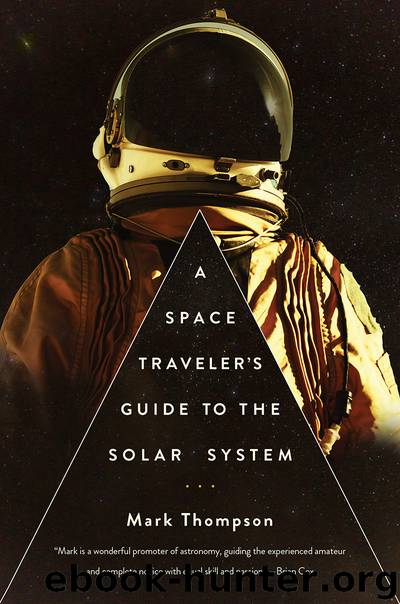A Space Traveler's Guide to the Solar System by Mark Thompson

Author:Mark Thompson
Language: eng
Format: epub
Publisher: Pegasus Books
SIX
A Goliath Among Planets
LEAVING THE ASTEROID BELT behind marks a new phase in your journey. With the exception of the Sun, all the objects you have visited so far have been rocky bodies with a solid crust on which you could move around, and they all belong to the group known as the inner planets. Beyond the asteroid belt is the realm of the gas giants Jupiter, Saturn, Uranus and Neptune, and it is to these planets our attention must now turn.
It was the invention of the telescope that really helped us to understand the secrets of the gas giants. Jupiter, the next destination, was particularly interesting, and not only did telescopic study reveal a little about the nature of its atmosphere and the many moons in orbit around it, it also led to the discovery in 1676 of the speed of light.
The discovery of the speed of light goes back to the hunt for a solution to identify longitude while at sea. To solve that problem, Galileo proposed the idea of taking accurate timings of the eclipses of the moons of Jupiter, which he had discovered earlier in the seventeenth century. The idea stemmed from the fact that all these moons orbit around Jupiter in a very regular fashion and, given that the key to pinpointing your location on Earth relied on accurately telling the time from your location, eclipses of the moons would be a more reliable clock than the man-made clocks of the day. Accurate tables were produced that predicted the numerous eclipses over the years and, in principle at least, by observing an eclipse you could work out the time. A great idea, but a flawed one given that accurate telescopic observation from the deck of a heaving ship was difficult if not impossible.
Several decades later a young Danish astronomer by the name of Ole Rømer was working with colleagues to accurately time some of the eclipses, and in doing so he made a rather startling discovery. He made a series of observations between March 1672 and April 1673 which revealed that the eclipses were taking place later than predicted. By estimating the position of Jupiter and Earth in their orbits as he recorded the timings he was able to deduce that it took light about twenty-two minutes to traverse the diameter of the Earth’s orbit. With more accurate observations in the years that followed, better estimates of the speed of light were achieved. In 1809, Jean Baptiste Delambre calculated that it takes light eight minutes and twelve seconds to travel the distance between the Earth and the Sun, leading to a value for the speed of light of just over 300,000 kilometres per second – quite an impressive calculation given today’s value of 299,910 kilometres per second. It is incredible that the study of a planet that comes no closer than 630 million kilometres to Earth allowed us to deduce the speed of light.
By knowing the parameters of the Earth’s orbit we can time how
Download
This site does not store any files on its server. We only index and link to content provided by other sites. Please contact the content providers to delete copyright contents if any and email us, we'll remove relevant links or contents immediately.
| Aerodynamics | Aircraft Design & Construction |
| Astronautics & Space Flight | Avionics |
| Gas Dynamics | Propulsion Technology |
Whiskies Galore by Ian Buxton(41867)
Introduction to Aircraft Design (Cambridge Aerospace Series) by John P. Fielding(33064)
Small Unmanned Fixed-wing Aircraft Design by Andrew J. Keane Andras Sobester James P. Scanlan & András Sóbester & James P. Scanlan(32743)
Craft Beer for the Homebrewer by Michael Agnew(18140)
Turbulence by E. J. Noyes(7935)
The Complete Stick Figure Physics Tutorials by Allen Sarah(7307)
Kaplan MCAT General Chemistry Review by Kaplan(6866)
The Thirst by Nesbo Jo(6826)
Bad Blood by John Carreyrou(6543)
Modelling of Convective Heat and Mass Transfer in Rotating Flows by Igor V. Shevchuk(6391)
Learning SQL by Alan Beaulieu(6208)
Weapons of Math Destruction by Cathy O'Neil(6139)
Man-made Catastrophes and Risk Information Concealment by Dmitry Chernov & Didier Sornette(5921)
Digital Minimalism by Cal Newport;(5661)
Life 3.0: Being Human in the Age of Artificial Intelligence by Tegmark Max(5474)
iGen by Jean M. Twenge(5366)
Secrets of Antigravity Propulsion: Tesla, UFOs, and Classified Aerospace Technology by Ph.D. Paul A. Laviolette(5309)
Design of Trajectory Optimization Approach for Space Maneuver Vehicle Skip Entry Problems by Runqi Chai & Al Savvaris & Antonios Tsourdos & Senchun Chai(5011)
Electronic Devices & Circuits by Jacob Millman & Christos C. Halkias(4907)
